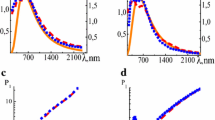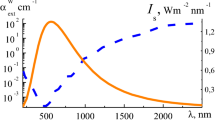Abstract
Theoretical investigation and selection of the optical properties of homogeneous metallic (titanium Ti, gold Au) and metal core–oxide shell (Ti–TiO2) nanoparticles with the radii 50, 75, 100 and 125 nm and their nanofluids have been carried out in the spectral interval 200–2500 nm for the purpose of effective absorption of solar radiation. Selected Ti and Ti–TiO2 nanoparticles with the radii 75–100 nm, in some cases up to 125 nm, are good absorbers in the visible and infrared spectral intervals and can be proposed for their use in solar thermal systems. Extinction and absorption of solar radiation by nanofluids (nanoparticles and water) are determined by the dominant influence of the system of Ti and Ti + TiO2 nanoparticles with concentration 109 cm−3 in the spectral interval 200–800 nm for the radii 50–75 nm and in interval 200–1100 nm for the radii 100–125 nm, and water dominantly influences the radiation extinction by nanofluid in the spectral range 1200–2500 nm.





Similar content being viewed by others
References
Reddy KS, Kamnapure NR, Srivastava S (2017) Nanofluid and nanocomposite applications in solar energy conversion systems for performance enhancement: a review. Int J Low-Carbon Technol 12:1–23
Hussein AK (2016) Applications of nanotechnology to improve the performance of solar collectors—recent advances and overview. Renew Sustain Environ Rev 62:767–792
Verma SK, Tiwari AK (2015) Progress of nanofluid application in solar collectors: a review. Energy Convers Manag 100:324–346
Leong K, Ong HC, Amer NH, Norazrina MJ, Risby MS (2016) An overview on current application of nanofluids in solar thermal collector and its challenges. Renew Sustain Environ Rev 53:1092–1105
Verma SK, Tiwari AK, Chauhan DS (2017) Experimental evaluation of flat plate solar collector using nanofluids. Energy Convers Manag 134:103–115
Bohren CF, Huffman DR (1983) Absorption and scattering of light by small NPs. Wiley, New York
Gorji TB, Ranjbar AA (2017) A review on optical properties and application of nanofluids in direct absorption solar collectors (DASCs). Renew Sustain Environ Rev 72:10–32
Pustovalov VK, Astafyeva LG, Fritzsche W (2015) Analysis of optical properties of spherical metallic NPs for effective absorption of solar radiation and their heating. Sol Energy 122:1334–1341
Astafyeva L, Pustovalov V (2016) Efficiency of absorption of solar radiation by liquids containing metallic NPs. J Appl Spectrosc 83:218–224
Qin Z, Wang Y, Randrianaliso J, Raeesi V, Chan V, Lipiński V, Bischof J (2016) Quantitative comparison of photothermal heat generation between gold nanospheres and nanorods. Sci Rep 6:29836
Zhang H, Chen H-J, Du X, Wen D (2014) Photothermal conversion characteristics of gold NP dispersions. Sol Energy 100:141–147
Chen M, He Y, Zhu J, Kim DR (2016) Enhancement of photo-thermal conversion using gold nanofluids with different particle sizes. Energy Convers Manag 112:21–30
Guo A, Fu Y, Wang G, Wang X (2017) Diameter effect of gold NPs on photothermal conversion for solar steam generation. RSC Adv 7:4815–4819
Chen M, He Y, Zhu J, Shuai Y, Jiang B, Huang Y (2015) An experimental investigation on sunlight absorption characteristics of silver nanofluids. Sol Energy 115:85–94
Gorji TB, Ranjbar A (2016) A numerical and experimental investigation on the performance of a low-flux direct absorption solar collector (DASC) using graphite, magnetite and silver nanofluids. Sol Energy 135:493–505
Ishii S, Sugavaneshwar R, Chen K, Dao T, Nagao T (2016) Solar water heating and vaporization with silicon NPs at Mie resonances. Opt Mater Express 6:640–648
Xuan Y, Duan H, Li Q (2014) Enhancement of solar energy absorption using plasmonic nanofluid based on TiO2/Ag composite NPs. RSC Adv 4:16206–16213
Pustovalov V, Astafyeva L, Fritzsche W (2017) Light-absorption selection of NPs and nanofluids containing NPs for their effective heating by solar radiation. Nanotechnol Environ Eng 2:7
Pustovalov V, Astafyeva L (2017) Spectral properties of nanofluids with homogeneous and bilayer NPs for efficient absorption of solar radiation. Opt Spectrosc 123:158–163
Wang Z, Zhang Z, Quan X, Cheng P (2018) A numerical study on effects of surrounding fluid, material, and geometry of nanoparticles on solar absorption efficiencies. Int J Heat Mass Transf 116:825–832
Astafyeva L, Pustovalov V (2016) Angular optical characteristics of light scattered by double-layer metal–oxide NPs. Opt Spectrosc 121:109–114
Amjad M, Razaa G, Xinc Y, Pervaiza S, Xuc J, Duc X, Wen D (2017) Volumetric solar heating and steam generation via gold nanofluids. Appl Energy 206:393–400
Pustovalov VK (2016) Light-to-heat conversion and heating of single nanoparticles, their assemblies, and surrounding fluid under laser pulses. Review. RSC Adv 6:81266–81289
Bessekhouad Y, Robert D, Weber J (2003) Preparation of TiO2 nanoparticles by sol–gel route. Int J Photoenergy 5:153–158
Prasad K, Jha A, Kulkarni A (2007) Lactobacillus assisted synthesis of titanium nanoparticles. Nanoscale Res Lett 2:248–250
Hierrezuelo J, Sadeghpour A, Szilagyi I, Vaccaro A, Borkovec M (2010) Electrostatic stabilization of charged colloidal particles with adsorbed polyelectrolytes of opposite charge. Langmuir 26:15109–15111
Hale G, Querry M (1973) Optical constants of water in the 200 nm to 200 μm wavelength region. Appl Opt 12:555–563
ASTM G173-03 (2012) Standard tables for reference solar spectral irradiances: direct normal and hemispherical on 37° tilted surface
Born M, Wolf E (1964) Principles of optics. Pergamon Press, Oxford
Refractive Index Database (2018) http://refractiveindex.info/
Author information
Authors and Affiliations
Corresponding author
Rights and permissions
About this article
Cite this article
Pustovalov, V.K., Astafyeva, L.G. Optical properties of nanoparticles and nanofluids for direct absorption of solar radiation. Nanotechnol. Environ. Eng. 3, 15 (2018). https://doi.org/10.1007/s41204-018-0044-0
Received:
Accepted:
Published:
DOI: https://doi.org/10.1007/s41204-018-0044-0




